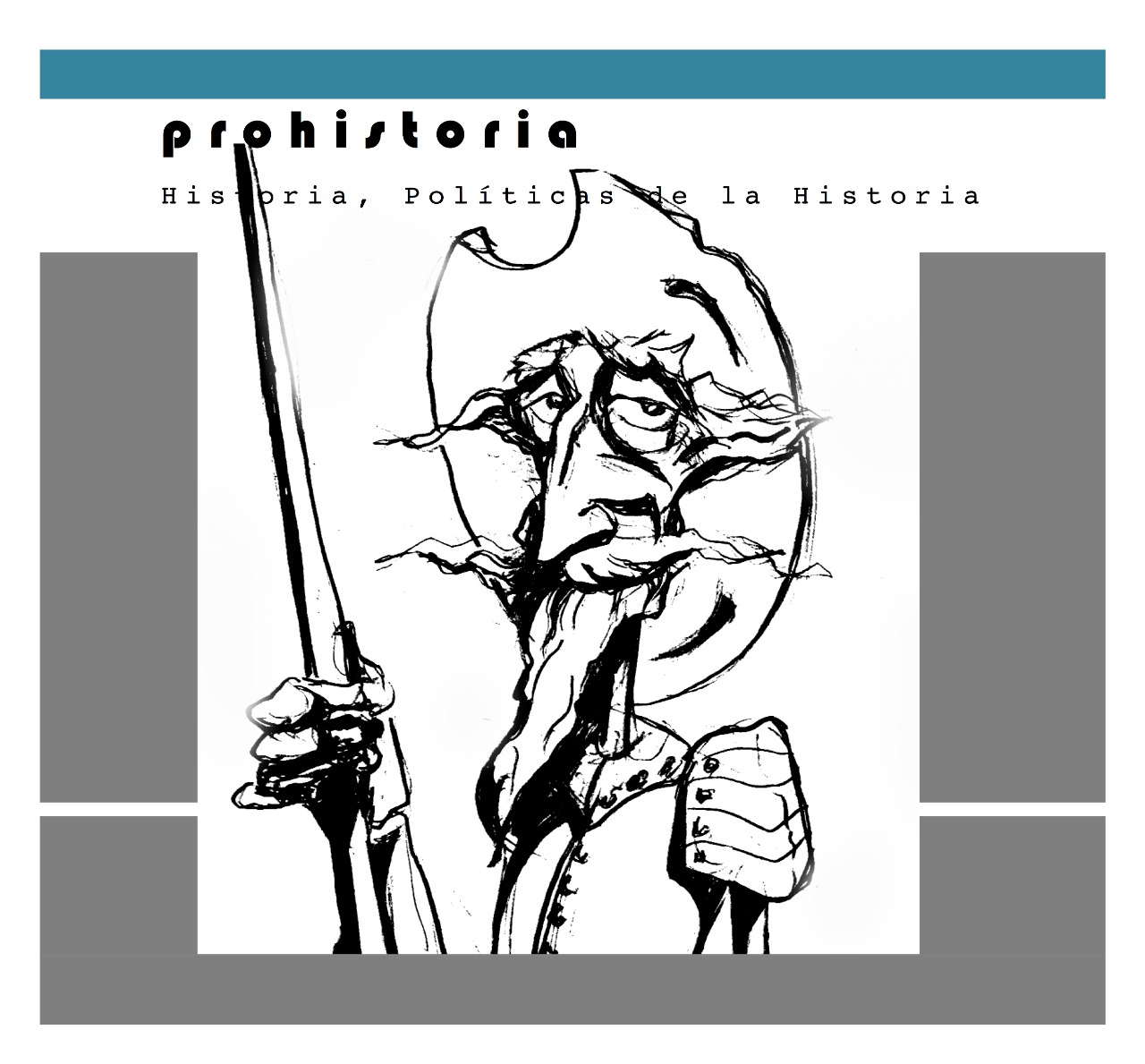Historias conectadas: notas para una reconfiguración de Eurasia en la modernidad temprana
DOI:
https://doi.org/10.35305/prohistoria.vi33.1079Palavras-chave:
Historias Conectadas, Modernidad, Eurasia, Circulación de IdeasResumo
Se presenta una traducción del seminal artículo de Sanjay Subrahmanyam. En 1997, el historiador del sudeste asiático sintetizaba su propuesta metodológica para el abordaje de los albores de la modernidad y de sus profundas transformaciones culturales. Se trata de las “historias conectadas”, una perspectiva superadora del análisis comparativo y de su tendencia a reproducir recortes geográficos apriorísticos y anclados habitualmente en los marcos del Estado-nación moderno. Las historias conectadas reconocen los puntos de contacto –epicentros históricos– donde se produjeron diálogos e intercambios entre unidades políticas y culturales, cuya influencia reverberó a nivel local, regional y global.
Downloads
Referências
Alam, Muzaffar y Sanjay Subrahmanyam (1994). “L'Etat Moghol et sa fiscalité”, Annales HSS 49, 1, pp. 189-217.
Aubin, Jean (1988). “L'avenement des safavides réconsideré”, Moyen Orient et Océan Indien 5, París: Société d'histoire de l'Orient, pp. 1-130.
Babayan, Kathrine (1993). The Waning of the Qizilbash: The Temporal and the Spiritual in Seventeenth-Century Iran, Tesis Doctoral, Princeton, N.J.: Princeton University Press.
— (2003). Mystics, Monarchs, and Messiahs: Cultural Landscapes of Early Modern Iran, Cambridge: Harvard University Press.
Banerjee, S. N. y John S. Hoyland (trad.) (1922). The Commentary of Father Monserrate SJ. on his Journey to the Court of Akbar, Londres, Bombay: Humphrey Milford, Oxford University Press.
Calmard, Jean (ed.) (1993). Études safavides, París y Teheran: Institut français de recherche en Iran.
Crosby, Alfred (1972). The Columbian Exchange. Biological and Cultural Consequences of 1492, Westport: Greenwood Publishing Company.
— (1986). Ecological Imperialism. The Biological Expansion of Europe, 900-1900, Cambridge, Nueva York: Cambridge University Press.
Davis, Natalie Zemon (1986). “Boundaries and the Sense of Self in Sixteenth-Century France”, en Heller, Thomas C., Morton Sosna y David E. Wellbery (eds.), Reconstructing Individualism: Autonomy, Individuality and the Self in Western Thought, Stanford: Stanford University Press, pp. 53-63.
Dikotter, Frank (1995). “Parallel Modernities: Normalization, Individuation and the Biologizing Process in China”, ponencia presentada en el seminario “El contexto eurasiático de la historia moderna del sudeste del Asia continental, c. 1400-1800”, en el Centro de Estudios del Sudeste Asiático [SOAS - South Asia Institute], 22-24 de junio.
Fleischer, Cornell H. (2018). “A Mediterranean Apocalypse: Prophecies of Empire in the Fifteenth and Sixteenth Centuries”, Journal of the Economic and Social History of the Orient 61, 1-2, pp. 18-90.
Fletcher, Joseph (1986). “The Mongols: Ecological and Social Perspectives”, Harvard Journal of Asiatic Studies 46, 1, pp. 11-50.
Forbes Manz, Beatrice (1989). The Rise and Rule of Tamerlane, Cambridge y Nueva York: Cambridge University Press.
Gaeffke, Peter (1994). “Alexander and the Bengali Sufis”, en Entwistle, Alan W. y Françoise Mallison (eds.), Studies in South Asian Devotional Literature, Research Papers, 1988-1991, Nueva Delhi: Manohar, pp. 275-284.
Gandjei, Tourkhan (1959). Il Canzoniere di Sháh Ismá'il, Nápoles: Istituto Universitario Orientale.
Godakumbura, Charles E. (1966). “Relations between Burma and Ceylon”, Journal of the Burma Research Society 44, 2, pp. 145-162.
Godinho, Vitorino Magalhães (1990). Mito e mercadoria, utopia e prática de navegar, séculos XIII-XVIII, Lisboa: Difusão Editorial.
Goldstone, Jack A. (1991). Revolution and Rebellion in the Early Modern World, Berkeley: University of California Press.
Grove, Richard (1994). Green Imperialism. Colonial Scientists, Ecological Crises and the History of Environmental Concern, 1600-1860, Cambridge, Delhi: Cambridge University Press.
Gruzinski, Serge (1985). Les Hommes-dieux du Mexique: Pouvoir indien et société coloniale, XVIe-XVIIe siècle, París: Éditions des Archives Contemporaines.
— (1988). La colonisation de l'imaginaire: Sociétés indigènes et occidentalisation dans le Mexique espagnol, XVIe-XVIIIe siècle, París: Gallimard.
Hamdani, Abbas (1979). “Columbus and the Recovery of Jerusalem”, Journal of the American Oriental Society 99, 1, pp. 39-48.
Hodgen, Margaret T. (1964). Early Anthropology in the Sixteenth and Seventeenth Century, Filadelfia: University of Pennsylvania Press.
Hosten, Henry (ed.) (1914). “Mongoliecae Legationis Commentarius or The First Jesuit Mission to Akbar”, en Memoirs of the Asiatic Society of Bengal 3, Calcuta, pp. 513-704.
Kafadar, Cemal (1989). “Self and Others: The Diary of a Dervish in Seventeenth Century Istanbul and First-person Narratives in Ottoman Literature”, Studia Islamica 69, pp. 121-150.
— (1991). “Les troubles monétaires de la fin du XVIe siècle et la prise de conscience ottomane du déclin”, Annales ESC 46, 2, pp. 381-400.
Kagan, Richard L. (1990). Lucrecia's Dreams: Politics and Prophecy in Sixteenth-Century Spain, Berkeley: University of California Press.
Kosugi, Keiko, Satake Akihiro y Jacqueline Pigeot (trad.), Voyages en d'autres mondes: Récits japonais du XVIe siecle, París: Philippe Picquier - Bibliothèque nationale de France.
Lieberman, Victor (1997). “Transcending East-West Dichotomies: State and Culture Formation in Six Ostensibly Disparate Areas”, Modern Asian Studies 31, 3, pp. 463-546.
— (1991). “Secular Trends in Burmese Economic History, c. 1350- 1830, and their Implications for State Formation”, Modern Asian Studies 25, 1, pp. 1-31.
— (1984). Burmese Administrative Cycles: Anarchy and Conquest, c. 1580-1760, Princeton, N.J.: Princeton University Press.
Lombard, Denys (1993). “Les Lusiades comparées a deux autres ‘visions’ de la fin du XVIe siecle: le Xi Yang Ji et le roman malais d'Alexandre”, en de Matos, Artur Teodoro y Luís Filipe F. Reis Thomaz (eds.), As Relações entre a Índia Portuguesa, a Ásia do Sueste e o Extremo Oriente, Macau-Lisboa: ISIPH, pp. 173-186.
Ludden, David (1994). “History Outside Civilisation and the Mobility of South Asia”, Journal of South Asian Studies, 17, 1, pp. 1-23.
Maclean, Derryl (2003). “The Sociology of Political Engagement: The Mahdaviyah and the State”, en Eaton, Richard M. (ed.), India's Islamic Traditions, 711-1750, Nueva Delhi: Oxford University Press, pp. 150-168.
Marshall, Peter James, Robert van Niel (et al.) (1988). The Ancien Régime in India and Indonesia, Leiden, Nueva York: Brill.
Mazzaoui, Michel M. (1990). “The Religious Policy of Shah Isma‘il II”, en Mazzaoui Michel M. y Vera B. Moreen (eds.), Intellectual Studies on Islam: Essays Written in Honour of Martin B. Dickson, Salt Lake City: University of Utah Press, pp. 49-56.
Minorsky, Vladimir (1942). “The Poetry of Shah Isma‘il I”, Bulletin of the School of Oriental and African Studies 10, 4, 1006a-1053a.
Mirza, Mohammad Wahid (1935). The Lije and Works of Amir Khusrau, Delhi.
Pagden, Anthony (1982). The Fall of Natural Man: The American Indian and the Origins of Comparative Ethnology, Cambridge: Cambridge University Press.
Parker, Geoffrey (1995a). “David or Goliath? Philip II and his World in the 1580s”, en Kagan, Richard L. y Geoffrey Parker (eds.), Spain, Europe and the Atlantic World: Essays in Honour of John H. Elliott, Cambridge: Cambridge University Press, pp. 245-266.
— (1995b). Philip II, Chicago: Open Court, 3ra ed.
Parker, Geoffrey y Lesley M. Smith (eds.) (1978). The General Crisis of the Seventeenth Century, Londres: Routledge and Kegan Paul.
Perlin, Frank (1994). Unbroken Landscape: Commodity, Category, Sign and Identity: Their Production, Strengths and Knowledge from 1500, Aldershot: Variorum; Brookfield: Ashgate Publishing.
Phelan, John L. (1970). The Millennial Kingdom of the Franciscans in the New World, Berkeley: University of California Press.
Phillips, Carla Rahn (1979). Ciudad Real, 1500-1750: Growth, Crisis and Readjustment in the Spanish Economy (Cambridge, Mass.: Harvard University Press.
Raymond, Catherine (1995). “Étude des relations religieuses entre le Sri Lanka et l'Arakan du XIIe au XVIIIe siècle: Documentation historique et évidences archéologiques”, Journal Asiatique 283, 2, pp. 469-501.
Salmon, Claudine (ed.) (1996). Récits de voyage des asiatiques: Genres, mentalités et conception de l'espace, París: Efeo.
Savory, Roger M. (1971). “A Curious Episode in Safavid History”, en Bosworth, Clifford E. (ed.), Iran and Islam: In Memory of the Late Vladimir Minorsky, Edimburgo: Edinburgh University Press, pp. 461-473.
Schwartz, Stuart (ed.) (1994). Implicit Understandings: Observing, Reporting, and Reflecting on the Encounters between Europeans and Other Peoples in the Early Modern Era, Cambridge y Nueva York: Cambridge University Press.
Seneviratne, H. L. (1978). Rituals of the Kandyan State, Cambridge: Cambridge University Press.
Sharif, Ahmad (ed.) (1977). Alâûl viracita Sikandarnâma, Dhaka: Bāmlā Ekādemī.
Sprenger, Aloys, Agha Muhammad Shustari y Moulawi Agha Ahmad Ali (eds.) (1852-1869). The Sikandar Namah-i-Bahri by Nizami, 2 vols., Calcuta: Asiatic Society of Bengal.
Steensgaard, Niels (1990). “The Seventeenth-century Crisis and the Unity of Eurasian History”, Modern Asian Studies 24, 4, pp. 683-697.
Subrahmanyam, Sanjay (1990). The Political Economy of Commerce: Southern India, 1500-1650, Cambridge, Cambridge University Press.
— (1993). The Portuguese Empire in Asia, 1500-1700: A Political and Economic History, Londres: Longman.
— (1994). “A Note on the Kabul Kingdom under Muhammad Hakim Mirza (1554-1585)”, La transmission du savoir dans le monde musulman périphérique, Lettre d'infórmation, núm. 14, pp. 89-101.
— (1999). “Persianisation and Mercantilism: Two Themes in Bay of Bengal History, 1400-1750”, en Lombard, Denys y Om Prakash (eds.), Trade and Cultural Contacts in the Bay of Bengal, 1400-1800, Delhi: Manohar, pp. 47-85.
— (2004). Explorations in Connected History, 2 vols., Delhi: Oxford University Press.
Tanaka, Yuko (1995). “Le monde comme représentation symbolique: Le Japon de l'époque d'Edo et l'univers du mitate”, Annales, Histoire, Sciences Sociales 50, 2, pp. 259-281.
Thomaz, Luís Filipe Ferreira Reis (1994). De Ceuta a Timor, Linda a Velha, Portugal: Difusão Editorial.
Valensi, Lucette (1987). Venise et la Sublime Porte: La naissance du despote, París: Hachette.
Weinstein, Donald (1970). Savonarola and Florence: Prophecy and Patriotism in the Renaissance, Princeton, N.J.: Princeton University Press.
Welch, Stuart Cary (1978). Imperial Mughal Painting, Londres: Chatto & Windus.
Zimmermann, Francis (1995). Généalogie des médecines douces: De l'Inde à l'Occident, París: Presses Universitaires de France.
Publicado
Como Citar
Edição
Seção
Licença

Este trabalho está licenciado sob uma licença Creative Commons Attribution-NonCommercial-ShareAlike 4.0 International License.
- Os autores retêm os direitos autorais e garantem à revista o direito da primeira publicação do trabalho, bem como uma Creative Commons Attribution 4.0 International License.
- Os autores podem estabelecer separadamente acordos adicionais para a distribuição não exclusiva da versão do trabalho publicado na revista (por exemplo, colocá-lo em um repositório institucional ou publicá-lo em um livro), com reconhecimento de sua publicação inicial nesta revista.
Copyright desta edição © Prohistoria. Historia, políticas de la historia












































